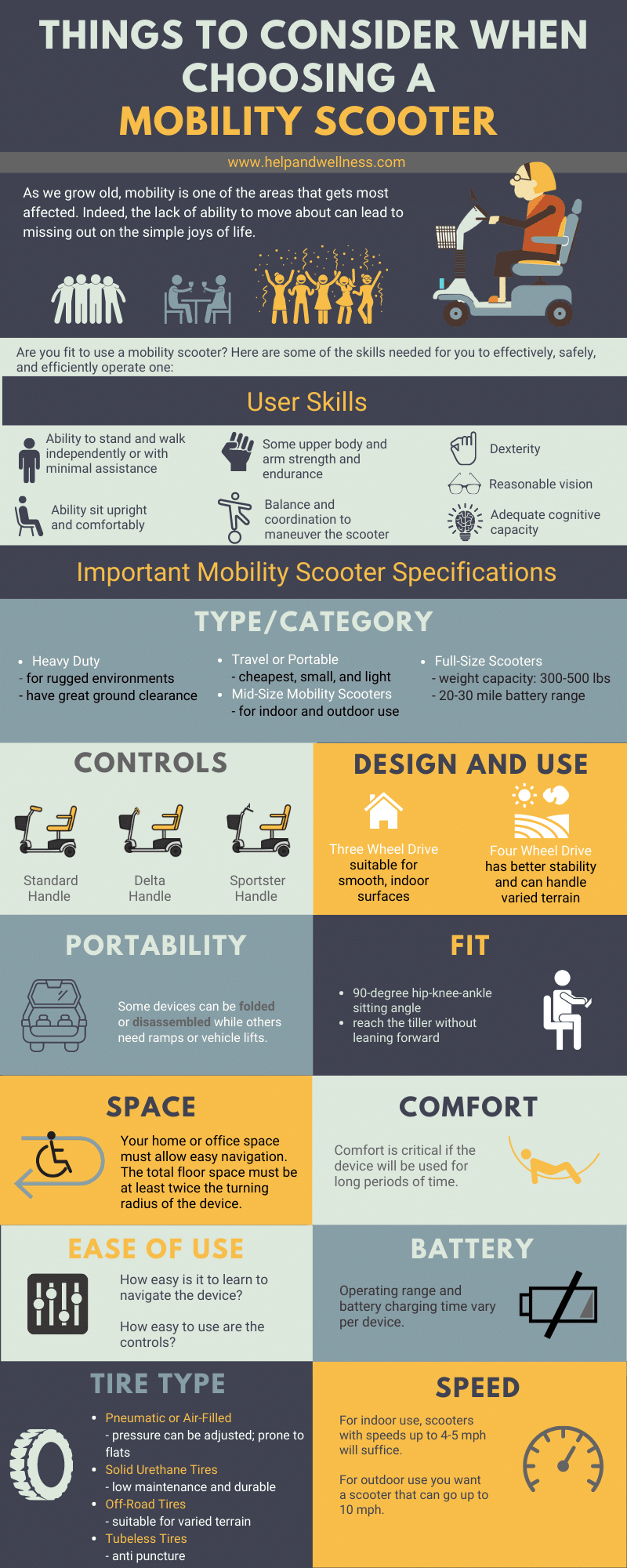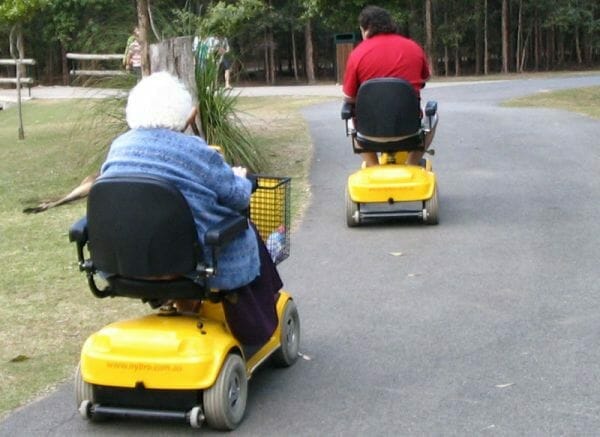Any significant purchase requires thorough decision-making. We are here to run along essential considerations to guide you in choosing the right mobility scooter for your needs and lifestyle.
Contents
Mobility is essential in independence. As we grow old, this is one of the areas that get affected. If not given enough attention, this lack of ability to move about can lead to missing out on simple joys of life, such as meeting with friends and performing hobbies.
Worse, this may eventually lead to isolation, low self-esteem and even feelings of depression and anxiety1. On the other hand, users of mobility scooters report improved engagement, participation, freedom, and social participation2.
Mobility Scooters
Mobility scooters are power mobility devices along with power wheelchairs. While power wheelchairs are designed for those who cannot walk, mobility scooters are designed for marginal ambulatory users, or those who can still walk for short distances but can benefit from intermittent use of mobility devices such as scooters.
User Skills
Before looking at mobility scooters’ specifications, it is crucial to see whether you are fit to use a mobility scooter. Here are some of the skills needed for you to effectively, safely, and efficiently operate a mobility scooter:
- Ability to stand and walk independently or only require limited assistance
- Good postural stability to sit upright comfortably
- Good balance and coordination to shift weight when needed
- Good enough upper body and arm strength and endurance to comfortably extend your arms at 90 degrees in front and hold the bar
- Good hand dexterity to steer (standard tillers need to be squeezed) and operate the switches and levers (delta tillers can be an option for those with limited dexterity)
- Adequate cognitive capacity, i.e., good concentration and good judgment to operate the device safely and efficiently
- Good vision
If you have all these skills, the next step is to consider your daily routine, preferences, and activities and find the mobility scooter specifications best suited for your needs.
You may also like Do Mobility Scooters Need Tax and Insurance and Other FAQs
Factors to Consider When Choosing the Best Mobility Scooter
Listed below are important specifications of mobility scooters that are essential to consider when choosing a mobility scooter to best meet your needs.
1. Type or Category
Travel or Portable Scooters
These are the cheapest among the different types of scooters available. They are small, and are designed to be light (as little as 50 pounds), portable, and easily disassembled. Some types could even be folded. They are most suitable for individuals who need to travel around and need their devices to be carried on public or private transportation.
The disadvantage of this type is that it exchanges portability to comfort and durability. So if you plan on using a scooter for more extended periods, this may not be the best mobility scooter for you.
Mid-Size Mobility Scooters
These types are designed to be used for both indoor and outdoor use. Some of these types are easily portable too, since they can be disassembled and packed in the car trunk.
Full-Size Scooters
These are suitable for both indoor (for those with larger homes) and outdoor use. Weight capacities of this category range from 300-500 pounds with 20-30 mile battery ranges.
Heavy-Duty Scooters
These types are designed to operate in rougher, more rugged environments. Compared to standard scooters, they have greater ground clearance (space between the ground and the scooter), enabling it to pass obstacles. They also have larger tires and can carry heavier loads (up to 500 pounds), good suspension systems, and large battery ranges.
Mid-Size Scooters
These types can be used both indoors and outdoors. They have large enough wheel sizes to be used indoors but offer easy maneuverability to be used indoors. These types can also be disassembled for easy transportability.
2. Controls
Standard Handle
These are T-shaped tillers or straight handlebars. They come with a thumb lever or switch at the middle that control forward and backward motion.
Delta Tiller
These provide less strain on the hands than a standard handle since the wrap-around style handle allows the user’s wrist to rest. This type allows users to drive using either hand and are recommended for those with limited dexterity and hand strength.
Sportster Handlebar
These are handles similar to those in motorcycles. This type requires dexterity to operate and may not be suited for users with insufficient hand strength and dexterity.
You may also like How To Start A Mobility Scooter Without A Key
3. Design and Use
Three-Wheel Drives
If you plan to use a scooter inside the home or in the office, you may want to consider using three-wheel drives. This type is more suited for use on smooth, indoor surfaces.
Most three-wheel drives are preferred for indoor use since they can fit through door frames and can maneuver around corners better since they have a smaller and sharper turning radius.
Four-Wheel Drives
If you plan on using a scooter outdoors, a four-wheel drive is more suited for you since it is more rugged and can handle varied terrain. This type has a broader wheelbase, which ensures better weight distribution, and therefore, better stability.
It has enough power to navigate curbs and high slopes and drive through bumps and uneven surfaces better than its three-wheeled counterpart.
4. Portability
If traveling is an integral part of the elderly’s routine, portability is paramount. Most travel and lightweight mobility scooters can be folded or disassembled into 4 to 5 pieces. This means that it can easily be placed in car trunks and be transported from one place to another. If you don’t like to disassemble your device, you will need a ramp or a vehicle lift to transport the device.
5. Space
Determine if your home or office can allow for easy navigation using the mobility scooter. To do this, check its total floor space (in length and width). It should be at least twice the turning radius of the device.
The turning radius or the minimal space needed for the device to execute a 180-degree turn can be found in the product specifications. Most scooters have a 33-55 inches turning radius.
The turning path of the device or the space needed to do an uninterrupted turn can be determined by doubling the turning radius’s value.
6. Fit
Users must be able to sit comfortably, with a 90-degree angle on the trunk and knee, with the feet resting comfortably on the base. You must be able to reach the tiller with your arms and hands without your trunk leaning or curving forward.
You may also like
7. Comfort
This is especially important if you’re projecting to use a scooter long-term. If the elderly individual will spend most of their day on a mobility scooter to do his daily tasks, comfort is critical. Seats have to be well-cushioned, padded, and contoured. Most users prefer Captain seats since these offer the most support and comfort. Swivel seats on the other hand help users get on and off of their scooters more easily.
The platform width of the scooter needs to be spacious enough to accommodate the user’s legs and feet. Four-wheel drives offer more legroom than three-wheel drives. Suspension systems also offer smoother rides.
Some scooters have adjustable seat heights and armrests, while others have reclining seats and headrests.
8. Ease of Use
Another important consideration is how easy it is to learn to navigate the device. Controls should be easy enough to use, especially for the elderly.
9. Tire Type
Pneumatic or Air-Filled
These tires are made of inner (air-filled) and outer parts. The advantage of this is that the air pressure could be adjusted. However, these kinds of tires require some maintenance and are prone to flats.
Solid Urethane Tires
These tires are solid, making them low maintenance and durable.
Off-Road Tires
These tires are suitable for use on-road, off-road, and other kinds of terrain. They have wide grooves and deep treads making them good options for use off-road, such as in the mud, gravel, or sand. Some offer wheels that are good for use in the snow.
Tubeless Tires
Unlike two-piece pneumatic tires, tubeless tires are one piece. They are anti-puncture. Some are even filled with special sealants to ensure that users won’t get a flat tire if they get punctured.
You may also like Best Bariatric Power Wheelchair
10. Weight Capacity
The weight capacity of a mobility scooter depends on its category. You have to make sure that your mobility scooter can accommodate not only your weight but even the things you want to carry, like shopping carts and extra batteries. Most scooters can hold up to 250 to 300 pounds while all-terrain and outdoor scooters can carry up to 500 pounds.
11. Speed
If you plan on using your mobility scooter mainly indoors, scooters with speeds up to 4-5mph will suffice. However, if you plan on using them outdoors for travel, some scooters have speeds that can go up to 10 mph. Most models allow you to set a maximum speed for the device. This is especially important if the user has coordination and balance problems where speed may pose a safety risk.
12. Battery and Operating Range
When choosing a mobility scooter, users must consider their usual routine to know if the scooter’s battery range will meet their needs. This is an important consideration if the elderly enjoy roaming around the community or if the scooter will be used for traveling or work. If you
Most scooters have an average operating range of 15 miles in a single charge while some can go up to 40 miles.
Battery charging time also varies, with some needing as little as two hours while others need overnight charging.
Like power wheelchairs, mobility scooters may have lead-acid, gel, or absorbent glass mat (AGM) batteries. While lead-acid types are the cheapest, they are not allowed for airline travel than the other two.
13. Accessories
Most scooters come with simple accessories like baskets. However, you can customize your scooters by purchasing other accessories to make your life easier. If visibility is a concern, look for scooters that offer LED lighting. Cup holders, USB charging ports, walker holder, cellphone holder, oxygen tank holder, and rear-view mirrors can be bought separately.
You may also like
Conclusion
Having a mobility scooter will not only solve the mobility problem of the elderly, it could even enhance participation and engagement, providing greater ease and convenience, and significantly promoting independence.
This is why it is very crucial to thoughtfully consider the myriad of specifications that come with these mobility scooters –– so that you get the most of what they can offer!
References:
1 https://www.ncbi.nlm.nih.gov/pmc/articles/PMC1495195/
2 https://www.tandfonline.com/doi/full/10.3109/17483107.2013.814171



